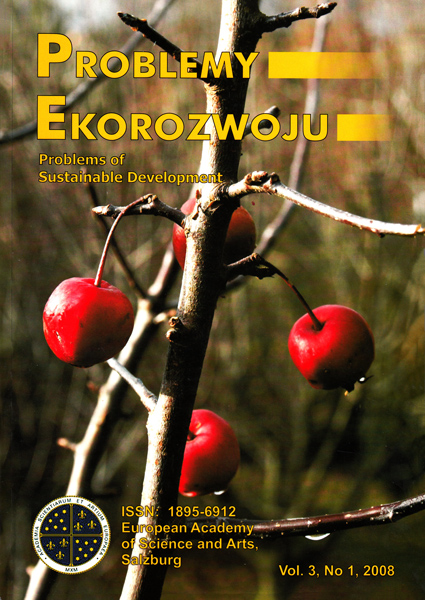Promoting Sustainability Through Green Chemistry, Part 1
Article Sidebar
Open full text
Issue Vol. 3 No. 1 (2008)
-
Stefan Kozłowski (1928-2007): Interwoven to the Rhythm of Nature
Krystyna Bonenberg5
-
The Role of Social Sciences and Philosophy in Shaping of the Sustainable Development Concept
Artur Pawłowski7-11
-
Sustainable Capitalism: A Matter of Ethics and Morality
John Ikerd13-22
-
Emission Reduction of Greenhouse Gases: Emission Quotas or Mandated Control Technologies
Dan Golomb23-25
-
The Philosophical and Social Conditioning of Sustainable Development
Zbigniew Hull27-31
-
Dilemmas for Sustainable Development in Poland
Jacek Jaśkiewicz33-38
-
Promoting Sustainability Through Green Chemistry, Part 1
Tadeusz Paryjczak39-44
-
Promoting Sustainability Through Green Chemistry, Part 2
Tadeusz Paryjczak45-51
-
Sustainable Development in Contemporary Civilisation. Part 1: The Environment and Sustainable Development
Artur Pawłowski, Lucjan Pawłowski53-65
-
The Philosophy of Dialogue as One of the Aspects to Sustainable Development
Irena Grochowska67-72
-
The Human-Animal Relationship in its Ecological Aspect
Stanisław Jedynak73-76
-
Book Review: Democracy in Space. Criticism of the Idea of “New Civilization” Presented by Prof. H. Skolimowski in His Book “Philosophy for a New Civilization”/ Recenzja
Paweł Dybel77-80
Archives
-
Vol. 5 No. 2
2010-07-01 21
-
Vol. 5 No. 1
2010-01-04 16
-
Vol. 4 No. 2
2009-07-01 19
-
Vol. 4 No. 1
2009-01-05 22
-
Vol. 3 No. 2
2008-07-01 19
-
Vol. 3 No. 1
2008-01-02 12
-
Vol. 2 No. 2
2007-07-02 13
-
Vol. 2 No. 1
2007-01-02 11
-
Vol. 1 No. 2
2006-07-03 15
-
Vol. 1 No. 1
2006-01-02 8
Main Article Content
Authors
Abstract
Green Chemistry is an important tool in achieving sustainability. The implementation of green chemistry, the design of chemical products and processes that reduce or eliminate the use and generation of hazardous substances, is essential if the expanding global populations to enjoy an increased standard of living without having a negative impact on the health of the planet. One of the major goods of sustainability is to maintain an optimal balance between increases in manufacturing output, and a clean and safe environment. Cleaner technologies will allow the chemical enterprise to provide society with the good and services on which it depends in an environmentally responsible manner. Green chemistry provides solutions to such global challenges as climate change, sustainable agriculture, energy, toxics in the environment and the depletion of natural resources. A collaborative effort by industry, academic and government is need to promote the adoption of the green chemistry technologies necessary to active a sustainable society.
Keywords:
References
ANASTAS P.T., Green Chemistry, Theory and Practice, Oxford University Pess, 1998.
ANASTAS P.T, BARTLETT L.B, KIRCHHOFF M.M, Williamson T.C.,2000, The role of catalysis in the design, development and implementation of green chemistry, w: Catalysis Today, vol. 55, s. 11-22.
ANGELA M, MEIRELES A., 2003, Supercritical extraction from solid; Process design data (2001-2003), w: Current Opinion in Solid State and Materials Science, Vol. 7, s.321- 330.
BURCZYK B., Zielona Chemia, zarys, Oficyna Wydawnicza Politechniki Wrocławskiej, Wrocław 2006.
CATO M.P, Origenes – De Agricultura.
CLARK J., MACQUARRIE D.J., Handbook of Green Chemistry and Technology, Blackwell, 44 Tadeusz Paryjczak/Problemy Ekorozwoju nr 3 (2008) , 39-44 2002.
McDONOUGH W., BRAUNGART M, ANASTAS P.T, ZIMMERMAN J.B., 2003, Applying the Principles Engineering, w: Environ. Science and Technology, December 1, s. 435-441.
GIRAY E.S., SONMEZ O.,2004, Supercritical extraction of scrap tire with different solvents and the effect of tire oil on the supercritical extraction of coal, w: Fuel Processing Technology, Vol. 85, s. 251-265.
MATLACK A.S., Introduction to Green Chemistry, Mareel Dekker Inc., New York 2001.
PARYJCZAK T., LEWICKI A., ZABORSKI M., Zielona Chemia, PAN, Oddział w Łodzi, Komisja Ochrony Środowiska, Łódź 2005.
PARYJCZAK T., LEWICKI A., 2006, Kataliza w zielonej chemii, w: Przemysł Chemiczny, Vol. 2, s. 85-95.
PARYJCZAK T., LEWICKI A., ZABORSKI M., Zielona chemia – przyszłość ochrony środowiska, w: red. Marciniec B., Misja chemii Wydawnictwo Poznańskie, Poznań 2004, s. 2990327.
PAWŁOWSKI A., 2006, Wielowymiarowość rozwoju zrównoważonego, w: Problemy Ekorozwoju, Vol. 1, No 1, s. 23-32.
PAWŁOWSKI A., 2007, Bariery we wdrażaniu rozwoju zrównoważonego – spojrzenie ekofilozofa, w: Problemy Ekorozwoju, Vol. 2, No 1, s. 59-65.
PERNAK J., 2003, Ciecze jonowe. Związki na miarę XXI wieku, w: Przem. Chem., Vol. 8, s. 521.
SHELDON R. A., 2000, Atom efficiency and catalysis in organic synthesis, w: Pure Appl. Chem., Vol. 72, No 7, s. 1233-1246.
TROST M.B., 1991, Science No 254, s. 1471.
WINTERTON N., 2001, Green Chem., No 3, s.73.
YEO S.D., KIRAU E., 2005, Formation of polymer particles with supercritical fluids, w: A. Review supercritical Fluids, No 34, s. 287-308.
AFONSO C.A.M., GRESPO J.G., (red.), Green Separation Processes Fundamentals and Application, Wiley-VCH Verlag, 2004.
Article Details
Abstract views: 71
License

This work is licensed under a Creative Commons Attribution-ShareAlike 4.0 International License.


